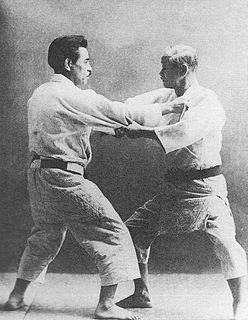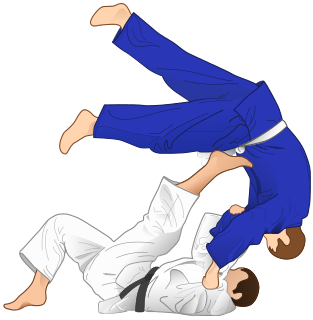
Nage-no-kata is one of the two Randori-no-kata of Kodokan Judo. It is intended as an illustration of the various concepts of nage-waza that exist in judo, and is used both as a training method and as a demonstration of understanding.

Tenjin Shinyo-ryu, meaning "Divine True Willow School", can be classified as a traditional school (koryū) of jujutsu. It was founded by Iso Mataemon Ryūkansai Minamoto no Masatari (磯又右衛門柳関斎源正足) in the 1830s. Its syllabus comprises atemi-waza, nage-waza, torae-waza and shime-waza. Once a very popular jujutsu system in Japan, among the famous students who studied the art were Kanō Jigorō, whose modern art of judo was greatly inspired by the Tenjin Shin'yō-ryū and Kitō-ryū.

Ju no Kata is a kata in Judo. It is designed to teach the fundamental principles of judo, especially the principle of ju . It consists in three sets of techniques and is performed by a pair of people one acting as an Uke and the other a Tori. The kata can be performed without wearing a judogi and, as it doesn't involve the completion of any throws, does not need to be performed in a dojo.
Itsutsu-no-kata is a kata in Judo. It consists in five techniques, known only by their number. Although popular media generally claim that it was developed by Jigoro Kano, recent scientific research has conclusively shown that the kata predates the foundation of Kodokan judo and that Jigoro Kano took it from Tenjin Shinyō-ryū jujutsu and merely imported it into judo after he made minor amendments to it. The kata is considered unfinished. However, a completed performance version of the kata, expanded to ten techniques, was recently presented under the name Tō-no-kata. The techniques of Itsutsu-no-kata are composed of gentle movements evocative of natural forces.

Uki otoshi (浮落), or "floating drop," is one of the traditional forty throws of Judo as developed by Jigoro Kano. It belongs to the fourth group, Dai Yonkyo, of the traditional throwing list, Gokyo-no-Nagewaza, of Kodokan Judo. It is also part of the current 67 Throws of Kodokan Judo. The technique is categorized as a hand technique, Te-waza.
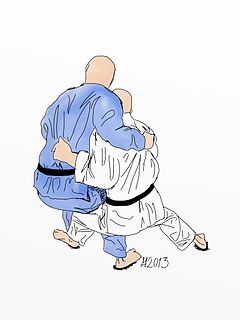
Tani otoshi (谷落) is one of the original 40 throws of Judo as developed by Kano Jigoro. It belongs to the fourth group of the traditional throwing list in the Gokyo no waza of the Kodokan Judo. It is also part of the current 67 Throws of Kodokan Judo. It is classified as a side sacrifice technique (yoko-sutemi).
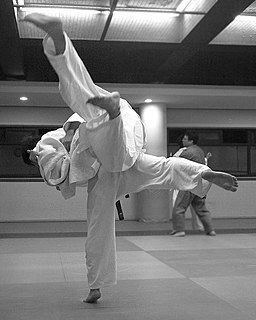
Ō guruma (大車) is one of the original 40 throws of Judo as developed by Kanō Jigorō. It belongs to the fourth group of the traditional throwing list in the Gokyo no waza of the Kodokan Judo. It is also part of the current 67 Throws of Kodokan Judo. It is classified as a foot technique (ashiwaza).
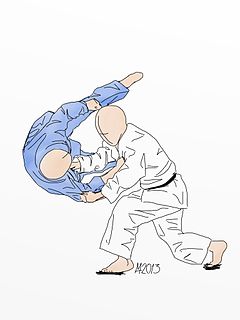
Sumi Otoshi (隅落), is one of the original 40 throws of Judo as developed by Jigoro Kano. It belongs to the fifth group, Gokyo, of the traditional throwing list, Gokyo, of Kodokan Judo. It is also part of the current 67 Throws of Kodokan Judo. It is classified as a hand technique, Te-waza.

The Canon of Judo is a book that was originally published in 1956, and written by Kodokan 10th dan, Kyuzo Mifune (1883-1965). The book covers almost all of the Kodokan recognized techniques, adds variations and new techniques, including Do-Jime in passing as well. The book also describes fifteen Kata developed by Mifune to teach adaptation through reversal and counters. The book organizes the techniques differently from the official Kodokan Gokyo.

Kanō Jigorō was a Japanese educator and athlete, the founder of Judo. Judo was the first Japanese martial art to gain widespread international recognition, and the first to become an official Olympic sport. Pedagogical innovations attributed to Kanō include the use of black and white belts, and the introduction of dan ranking to show the relative ranking among members of a martial art style. Well-known mottoes attributed to Kanō include "maximum efficiency with minimum effort" and "mutual welfare and benefit".
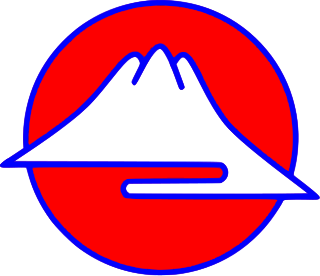
Yoseikan Aikido is the aikido taught at the Yoseikan Dojo in Shizuoka, Japan, under the direction of Minoru Mochizuki.
Tsutsumi Hōzan-ryū (堤宝山流) or Hōzan-ryū is a koryu sogo bujutsu or complete Japanese martial art.

Kyushin Ryu is a form of the martial art Jujutsu consisting of striking, throwing and grappling techniques. It was developed by the Samurai in feudal Japan as a method of dispatching an armored opponent using unarmed techniques. According to the Densho of various schools and historical records, these systems of unarmed combat began to be known as Jujutsu during the Muromachi period (1333–1568).

Jujutsu, also known as Jujitsu or Jiu-jitsu, is a Japanese martial art and a method of close combat for defeating an opponent in which one uses either a short weapon or none.

Tomita Tsunejirō, born Yamada Tsunejirō, was the earliest disciple of judo. His name appears in the first line of the enrollment book of the Kōdōkan. Tomita, together with Saigō Shirō, became the first in the history of judo to be awarded the rank of Shodan by the founder of judo, Kanō Jigorō, who established the ranking system that is now commonly used in various martial arts around the world. Tomita was known as one of the "Four Kings" of Kōdōkan judo for his victorious efforts in competing against jujitsu schools. He was awarded 7th dan upon his death on January 13, 1937.
Karate's Nage waza is the set of techniques whereby the opponent is thrown to the ground. While typical students of karate focus most of their attention on learning striking techniques, karate throws are considered indispensable for self-defense and, although not always taught, are part of the classical art.
Atemi Ju-Jitsu, in Japanese: Atemi (当て身) Jujutsu (柔術), also called Pariset Ju-Jitsu, was established in France in the 1940s by the late Judo and Ju-Jitsu legend Bernard Pariset to revive and preserve old martial techniques inherited from Feudal Japan. The Pariset family is sometimes referred to as the 'French Gracie', after having developed their own self-defense Jujitsu style directly inspired from the original Kano Jiujutsu and older koryū jujutsu systems developed to train Samurai warriors for defeating an armed and armored opponent on the battlefield. The Pariset family studied directly with Mikonosuke Kawaishi, his assistant Shozo Awazu, and Minoru Mochizuki. Kawaishi was a student of Jigoro Kano - founder of Judo, and Mochizuki was a student of Jigoro Kano, Gichin Funakoshi and Morihei Ueshiba - founders of Shotokan Karate and Aikido respectively.

